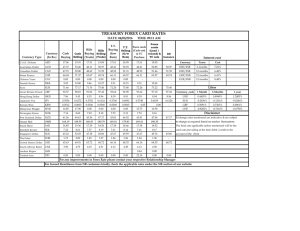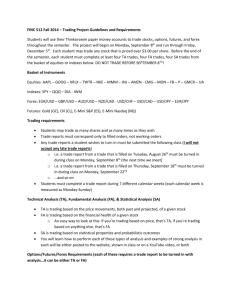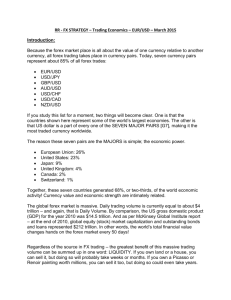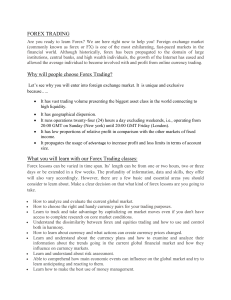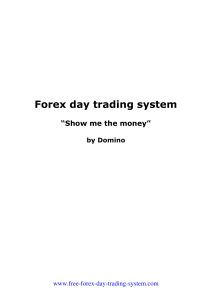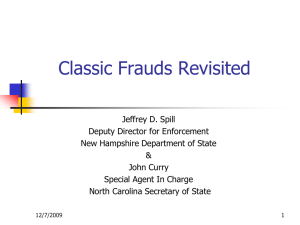Document
advertisement
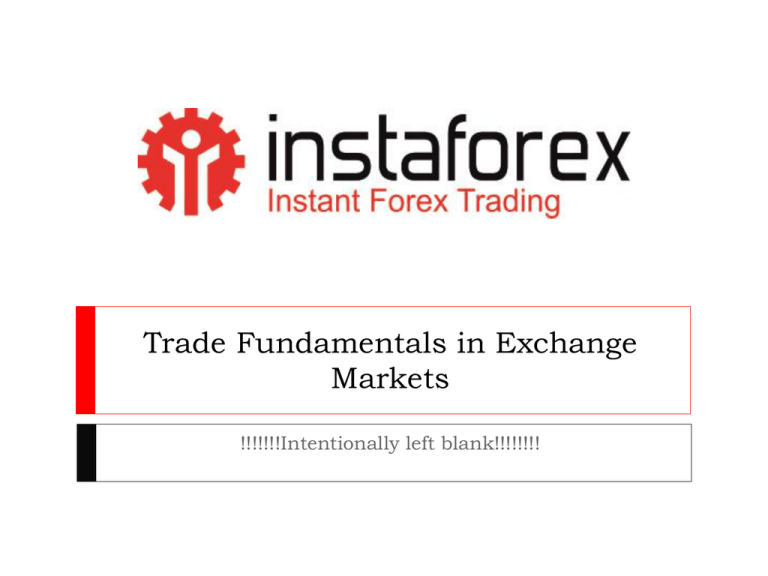
Trade Fundamentals in Exchange Markets !!!!!!!Intentionally left blank!!!!!!!! Content The Exchange Trade History and Its Concept Fundamental Analysis Technical Analysis Factors affecting the market tendencies Monetary policy Economic calendar Chart types Trend and tendencies Reversal patterns Capital Management Market enter signals Trading plan The Exchange Trade History and Its Concept Exchange (Bursa lat.) Found in 15th century, Brugge. Exchange Market Types Stock Mercantile (Commodity Exchange) FOREX “In usum negotiatorum cujuseungue nationis ac Linguae” (“For sales people of all nations and languages”) Commodity Exchange Instruments: Highly liquid goods and raw materials Clearing organizations Professional participants Private investors Organizers Subjects Stock Exchange Instruments: Shares of leading companies Clearing organizations Depositories Professional participants Private investors Organizers Subjects Foreign Exchange Instruments: Currency Ingots Precious metals ware Subjects Central banks Commercial banks Professional participants Pension funds Insurance companies Multinational corporations Private investors FOREX Market Advantages Minimal capital investments High liquidity No direct sales Exchange at any time High yield Large trade volume FOREX What is it? Concepts CFD (Contract for difference) Contract for Difference allows to earn on both rise and fall of price value Margin Amount taken as a collateral for position opening Taken at the time of trade opening at the open price and does not change anymore Margin trading The system works through a brokerage company providing leverage Margin Trading Features Small start-up capital Loans are granted in any currency Trading is carried out without real money Loan granting is charge-free in case of intraday trading Broker allows interest on customer’s available funds Trade is conducted remotely Exchange rates Base currency Quote currency Quote type EUR USD Reverse GBP USD Reverse USD JPY Direct USD CHF Direct GBP CHF Cross rate CAD JPY Cross rate FOREX: Predictable! Capital movement Data release and its expectation Policymakers announcements Fundamental Analysis Definition Purpose Method of price change forecasting through studying macroeconomic factors that influence the price Determination of a financial asset true value based on some macroeconomics factors News type Unexpected Scheduled Factors Affecting the Market Political Psychological Economic Force-majeure Instability in the country Meeting expectations Monetary policy Natural disasters Elections Underestimation of events Economic development Terrorism acts Scandal resignations Mistaken expectations Meeting of senior officials Official statements Press-conferences Political scandals Catastrophes Monetary Policy CB Interest rate correction Change of required reserves rate CB Interest rate – a rate at which commercial banks borrow funds from the Central Bank. Required reserves is a share of bank deposits in the Central Bank Open market operations – is a purchase/sale of government securities (bonds) Currency Intervention Definition Market enter of the CB for the purpose of forced adjustment of the national currency rate Target National currency cheapening of countries-exporters Country’s Economic Development Data Inflation Unemployment Socioeconomic phenomenon when a part of population cannot find a job GDP Depreciation of paper money due to its issue in sizes exceeding the turnover needs that is accompanied by commodities price upturn and real wages drop. Consumption + government spending + investments + export – import Trade Balance The difference between exports and imports of goods Economic Calendar Trading Sessions Session Stock Exchange GMT +3 Asian Tokyo, Singapore, Sydney. 01:00 – 09:00 European London, Frankfurt, Paris. 8:00 – 16:00 American New York 14:00 – 22:00 Technical Analysis Definition Purpose Research method for market dynamics based on studying historical data Forecasting of the future price movement Axioms Price includes everything Price moves in a certain direction History repeats itself Chart Types Line - closing price is marked only for every next period. Bar – shows maximal (high) and minimal prices (low), opening and closing prices. Japanese candlestick – a rectangle between opening and closing prices called candlestick body. A dash from a candlestick body to maximal (high) and minimal (low) price values within this timeframe is called shadow. Line Chart Japanese Candlestick Chart Timeframes М1, М5, М15, М30, H1, H4, D1, W1, MN 1M 1M 5M high 1M 1M close 1M open low Black Candle Formation max high open close min low White Candle Formation high max close open min low Trend Reversal Signals Shooting star Evening star Morning star Doji Open price = Close price Trend Trend is a vector of price movement Main rule: “Trend is your friend” Conclusion: “Do not work against trend” Trend Classification By duration Long-term– from 6 months to several years Medium-term– from 2 weeks to 6 months Short-term– up to 2 weeks By movement direction Ascending – price goes up. Descending – price goes down. Flat – no certain move direction Trend Line Definition Lines The line connecting successive data values for determining market direction. Support line – connects key lows of the market. Resistance line – connects key highs of the market. Levels Historical level– distinguishing level which the market remembers for a very long time. Psychological level – level occurring near round price values. Downtrend Uptrend and Local Trend Flat Reverse Pattern 1. Head & Shoulders Head 1st shoulder 2nd shoulder = Neck’s line sell Continuation or Reverse Pattern Triangle buy 1 Min= 200 pips = 2 3 4 = 5 sell Capital Management Investors Positional Speculative Tactics Averaging Locking Pyramid Theory of probability Trading Plan Definition Systematic description of individual trading Sections Descriptive part Information Analysis Forecast Market enter signals Target levels calculation Threats Trade opening or closing Results analysis FOREX entered the modern life and took its important place in it FOREX gives opportunity to earn money by your own effort and intellect FOREX and everything related to it are destined for success History of FOREX is just beginning Everyone has a chance to do part for the history of FOREX development!

